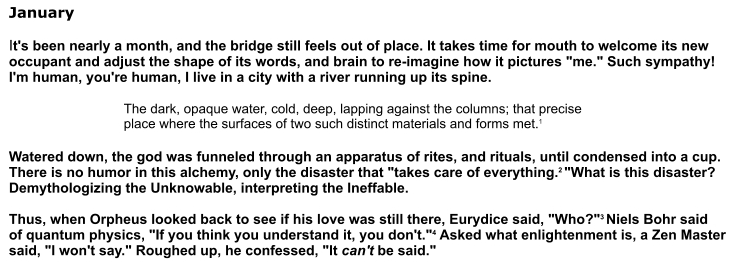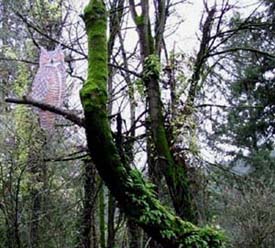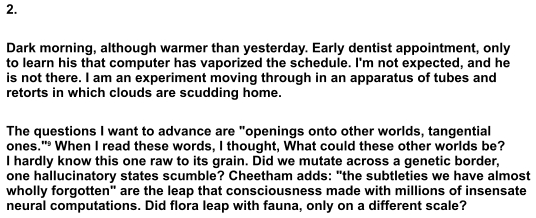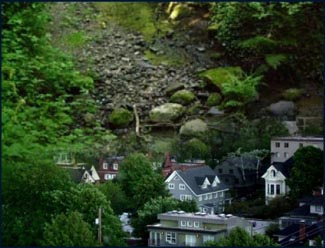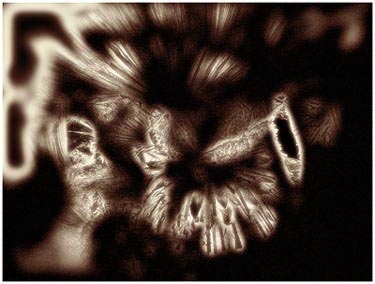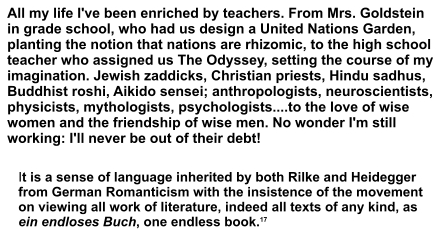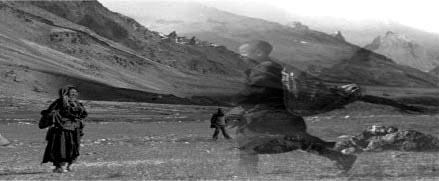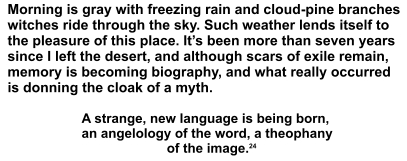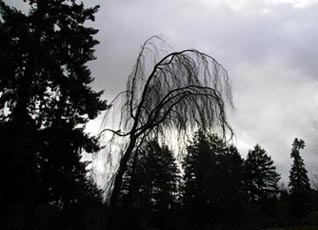
|
|
| Jan. 1 When I was a young writer living in New York, newly released from the Army, I worked in Brentano's, happily surrounded by thousands of paperback books. One day during lunch I read aloud to the other employees Kenneth Patchen's, "What Is the Beautiful," a long chant with the same refrain: And begin again.5 Patchen was a powerful anti-war poet, and also a romantic, blending passion with politics. Although the last years of his life he was in serious pain from botched surgery on his back, his metaphors were never exhausted. In general, most American political poems are inferior because they give off so much ephemeral heat. Even gifted poets, those who know how to dive into their words, usually drown in the shallows of Washington's reflective pool. As it's the first day of the year, there's a party. A bus takes me downtown, rolling toward and picking up speed over new construction rising around the river... we are organisms powered by molecules of water. Even when our homes are washed away, we return to the banks of the river as if it will never overflow again. Two teen-aged girls enter the bus, one immediately talking into her cell phone. It reminds me of, "You don't need something more to explain something more."6 Having no children of my own, I fancy that the letters of my DNA translate into words, sentences, paragraphs, instead of babies. My genes stop where my memes continue, as the bus rolls toward a house mottled with memories that flicker on and off like a faulty synaptic circuit. But first there's the bookstore, where I find the Christian Mysticism section on the bottom shelf. St. John of the Cross' "Dark Night of the Soul" is what I'm after, after which I walk to the party, where I have a long talk on Jung, metaphysics and religion, flavored with chocolate. Later, waiting on the bus stop in a gusty cold wind, after twenty minutes a woman appears who is listening to music on earbuds, and within a few minutes the bus arrives. Recently I read that "song birds rehearse their melodies in their sleep."7 Our brains, too, have evolved for dreaming, for archetypal journeying. That sleep depravation is classified as "harsh interrogation," the George W. Bush Administration's euphemism for torture, bears this out. Deprive us of sleep and we'll confess to anything. Only our dreams approach a cacophony of significant meaning.
. 4. Huge storms up and down the US West Coast today, wind and rain rattling windows and whistling through vents, bending and cracking trees. No doubt there's an angry god out there, but angry at whom?
It is like the moment when Carolyn Hanagan placed a paper crane made by a child in Hiroshima on the mass grave of Lakota Indians who were massacred by the U.S. Calvary at Wounded Knee. “A people dreamed there,” Black Elk said half a century before. “It was a beautiful dream.” The world you want won’t be the one you get. Are people who pray to a single god in danger similar to planting a single seed stock? Inge Kleivan wrote, “It was a great disappointment for the Greenlanders to learn (from the missionary) that there were no animals in heaven.”11 Hell, we're exterminating other species so fast we'll have Heaven-on-Earth in no time flat! How can we live this way and expect to survive? We don't. The accumulation of inheritable wealth, like spiritual weal, is more genetic paranoia than material greed. How this carries on!
Tonight I received a phone call from Terry Hauptman. I met Terry when she was a graduate student in the University of New Mexico's Department of English. The Amerindian poet Joy Harjo was her faculty advisor, and the Judeo-American poet, Gene Frumkin, was on her committee too. "Deep memory is a rebel bird alive with longing that unscrolls continuously, concealing the tumbling aspects of dawn, the hidden dark chambers.13 Terry exemplifies what William Paulson called "interdisciplinary from within."14
After leaving Albuquerque, Terry earned a Ph.D. in Interdisciplinary Arts from Ohio University, then joined her husband in Minnesota. When her phone call came we had not been in touch for over a decade. She was calling from New Hampshire, where her family now includes a daughter adopted in Guatemala. Terry continues to create multicultural poems and dynamic scrolls. . 8. Raining all day, although mild, no wind. On the day of the New Hampshire primary a phone call from there a few days ago has me thinking about synchronicities, how their invisible traces are the gaps our psyches span like ancient rope bridges swaying over an abyss. Decades ago, there was an exhibition of Mayan steles at the Albuquerque Museum. A videographer friend, allowed to film it before the public opening, invited me along. Without the gaze of guards, my fingers palpated hieroglyphic curves damp with the stone’s unsuspected organs, tracing a dermatoglyphic story that a linguist can never decipher.
Brock is addressing "the style of old age," that wonderfully elusive idealization I've been pursuing for most of my life. Abstract, yet grounded in suchness; disengaged from ephemeral struts, while passionately dismanteling orthodoxies; fading like a Navajo blanket until woof and warp are coeval with the fine line of the spirit's thread leading over the edge. For several weeks I've been reading Robert Romanyshyn's important book, The Wounded Researcher.3 "In writing this book," he says, "I must confess, I have become the very thing that I have been writing about. I have become the wounded researcher who is telling the tale of the Wounded Researcher." In this vein, people who do the torturer's work, no matter which flag, ideology, or dogma they salute, are themselves tortured souls. What is this soul? Writing under the sign of Jungian epistemology, Romanyshyn says, “at bottom soul and nature are one." To which he adds, that, no matter what your individual beliefs, "we (all) partake of this wholeness and belong to this web of interconnections.” . 9. Drove down from Vancouver, Washington, just over to Oregon border, the van bumping over potted gray freeway pavement. In 1955, “drive, he sd…,” Robert Creeley wrote. It was a time when gasoline in America was cheap and plentiful, when Kerouac scribbled while Cassidy drove, when Snyder hitchhiked coast to coast notebook in hand. Like the preciseness of his words and line-breaks, Creeley wrote his famous poem, "I Know a Man," at just the right time. By the turn of the next century we were learning how to live in the gaps, tweaking the audacity of our limitations, anticipating quarks of paradox, and loving for the sake of the ride. . 10. I am appalled and excited at seeing reports from this year's Consumer Electronics Show, in Las Vegas, NV. (Las Vegas, NM is where the State Mental Hospital is located.) Already the overflowing cornucopia of must-have electronic gadgets is draining deliberative thinking, discursive communication, thus education. But resistance is futile.
.
. . . . . . . 13. "It is a commonplace of all religious thought, even the most primitive, that the man seeking visions and insight must go apart from his fellows and live for a time in the wilderness."18 Even now, every time I stand at the edge of the forest I wonder what is lacking that draws me in?
After weeks of rain, the sky finally clear, the sun appears to be glaring down. An omnipresent God is understandable in the desert, but not beneath this canopy of trees.
When I returned to the Pacific Northwest, I hoped I could resolve feelings leftover from the 1960s. Of course the culture is not the same, nor am I. Instead of mass movements there are subtle tremors."Did you feel that?"
Douglas Fir, Western Hemlock, Oregon White Oak, Dawn Redwood...each with a unique personality. Trees don't have a face, so we rarely recognize their singularity. Even when we know their family name, it's not the same as recognition by the way they stand or sway. 17. Snow from a cold overhung sky was not predicted. Weathermen have no insight into disturbances that begin in the ocean. They are not educated to Poseidon. This younger brother of Zeus makes waves too large for even the best surfers to ride. A tsumani is a trough to Horseherder, Saltlicker, Earthshaker... changeable as the weather. The people of New Orleans prayed to a desert god, and drowned in their tears. . 18. Attended a talk tonight by J. Pittman McGehee, sponsored by Oregon Friends of C.G. Jung. It was titled, "The Incalculable Paradoxes of Love." McGehee is an ex-Episcopal priest and a Jungian analyst living in Houston, TX. "Many times," McGehee said, "what we call love is the need to have an identity." Then, "I know of no better balm for soothing anxiety than to be known." He added,"There is a transforming power in being known." But this can also work as a destructive force, as in the case of persons transformed by the media into celebrities who are too immature to handle being seen as fetishized objects. As for self-love, McGehee doesn't see it as necessarily negative, citing the hackneyed: One must love oneself before one can love another. However, if I understood him correctly, he doesn't mean self-love in the narcissistic sense, but more in the sense of seeing oneself as worthy of respect. Unfortunately, he didn't discuss the relationship between love and respect. Without further explanation, this is also misleading, as it ignores the ephemeral self as an illusionary construct of the mind, and thus lends itself, without disruption, to the mythology of Heaven and Hell. It seems that the Episcopal priest is still lurking, even if he has dissolved the image of an anthropomorphic God. McGehee also raised the need to be alone, offering that "there is a large difference between solitude and isolation." "Isolation is a pathological fear of being known," he said. I wonder if it is rather the fear of being found out, of one's mask slipping. Is solitude, then, isolation without the fear of being known? I thought of the Christian Desert Fathers of the Fourth Century Near East, whom Thomas Merton wrote, "had much in common with Indian Yogis and Zen Buddhist monks of China and Japan. If we were to seek their like in contgemporary America we would have to look in strange, out of the way places."20 In 1968, Merton twice visited the Monastery of Christ in the Desert, in northern New Mexico, near where Georgia O'Keeffe had partly immured herself. But he decided to continue his quest in northern India, where he planned to spend one year practicing Tibetan Buddhist meditation. Then suddenly died. Thinking of Tibet, then, I considered the training of a lung-gom-pa. Three years, three months, and three days sealed in small cave. Living on a meager diet slid through a slot, one's time is spent with intricate visualizations. The etymology of "to suffer," McGehee pointed out , is "to carry from beneath." So the initiate conjures up and carries his visions through the darkness of his soul. When he finally emerges from his tomb, the lama is able to travel for several days and nights in a steady loping run without stopping for food or rest. Perhaps the entombed Christ was too impatient?
A short warm run for a lung-gom-pa for me is a long cold walk. Tibetan Buddhists who practice g Tum-mo can wrap cold wet sheets around their naked bodies and, instead of becoming hypothermic, their skin gives off steam.22 On the other hand, Zen Buddhists shiver when it's cold, sweat when it's hot. Each Way has its own way. . 23. "Hail to the spirits who link us / because spontaneous abortion helps us see that we are not actually separate from our environment, whether it is the environment of the womb or the environment of the planet. With each conception of a being, the conception is only the beginning. We are all very much dependent on the environment, and no one more so than a tiny embryo or fetus in its mother's womb. The universe does not guarantee we live symbolically."23 One is named, guided by family, minister, teachers, friends. Reaching adolescence, powerful hormones are released. Only by law does one enter adulthood at a specific age, as maturity is not a threshold one crosses but a journey of deepening ones answers to fundamental questions.
. 26.
.
|
